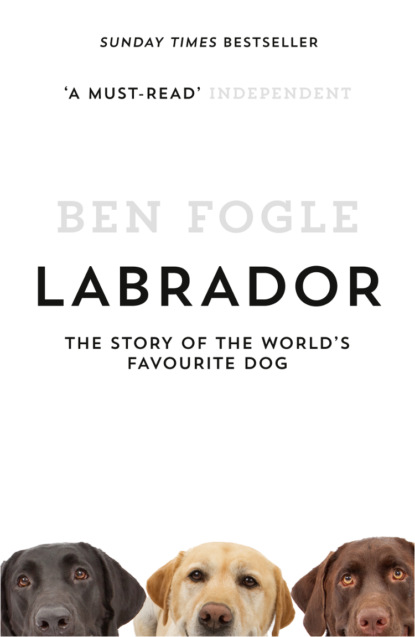По всем вопросам обращайтесь на: info@litportal.ru
(©) 2003-2024.
✖
Labrador: The Story of the World’s Favourite Dog
Настройки чтения
Размер шрифта
Высота строк
Поля
The earliest known depiction of the St John’s water dog – owned by a Mr Alsop – was on the canvas of the famous animal painter Edwin Landseer in 1822. Initially entitled Watchful Sentinel and known now as Cora. A Labrador Dog, the commissioned portrait of a much-loved pet shows a black dog with white paws and chest lying inside a stable yard or carriage house, with horses and grooms working in the background and, interestingly, no water in sight. (The earliest portrait of a yellow dog is believed to be in the Bowes Museum at Barnard Castle in County Durham – a portrait in oils of Mrs Josephine Bowes painted in the late 1840s with a yellow dog called Bernardine at her side.) This seems to be the moment these early ‘Labradors’ made the transition from sea to land. These dogs, seen and admired for their eye-catching skills in West Country ports and harbours, were being purchased for use on land.
For a land famous for two world-class dogs, there was a distinct lack of canine activity as I wandered the tiny fishing ports. I spotted a single working Collie. In the absence of either of the region’s namesakes, I arranged to meet two of the region’s living mascots. Gus the Labrador and Felix the Newfie are both employed by the State to greet people arriving in the remote territory, predominantly by cruise ship.
We arranged to meet in a tiny harbour that is now home to an artisan collective where artists produce paintings and knitwear. It was a picture-postcard, perfect location. Bright yellow fishing houses with faded red piers were reflected perfectly in the calm waters. Here, away from the rough Atlantic surf, I could image Labradors plying these waters collecting fallen fish and fishing tackle.
As instincts required, Gus belly dived into the clear waters. It was like an echo of an earlier time as I imagined his early cousins swimming in these very waters for the fisherfolk.
The extraordinary twist in this furry tail is that Gus’s provenance owed more to England than it did to those early pioneers. Indeed, his distant relatives had come up from Portugal to this remote land, only to traverse the Atlantic Ocean once again, back to Europe.
For the fortune-hunting fishermen, dog trading had become a lucrative subsidiary. The sale of fish was the main business, but canny sailors also sold the ice used to preserve their catch and, increasingly, established a dog import trade. The dogs’ water skills were much talked about. They feature in old stories as near-mythical water dogs, as fetchers of sailors’ hats in icy waters and blustery gales, big-hearted, eminently trainable and intelligent. They could swim with ropes in their mouths and sometimes – so the stories went – paddled out to the aid of ships in distress. They retrieved whatever their master bade them. The proud seamen put on a remarkable show of human–dog teamwork for the quayside crowds.
Wilson Stephens wrote in The Field,‘No wonder that the deck dogs on the ships off-loading in Poole Harbour caught the eye of passers-by. Perhaps the crew men entertained the locals by throwing overboard things which the dogs would retrieve, demonstrating their expertise at diving in and swimming back with a load. Perhaps bets were struck. No wonder, either, that the impression they made caught the eye of the local gentry – strolling, as all men do, on the quaysides …’
One spectator was the second Earl of Malmesbury, an MP and sportsman, born in 1778. He kept detailed records of the game he shot and of local and national weather. A large part of his estate at Hurn, in Dorset, included the floodplain between the River Stour and River Avon, north-east of Bournemouth. Hurn is listed in the Domesday Book as ‘Herne’; the name comes from the old English ‘hyrne’, meaning a disused part of a field or the land created by an oxbow lake. The Earl was fascinated by these amazing water retrievers. Until drainage operations in the mid-twentieth century, the River Stour had been habitually liable to winter overflow, spilling over its banks so that water spread over the countryside, creating large watery meadows a metre or more deep. The land was crisscrossed with carrier channels to control the annual floodwater; for half the year it was, as one observer put it, ‘a minor Venice’. The quantity of water was such that a raised causeway had been built around a 16-hectare floodable meadow so that the ladies of the house could continue to enjoy their carriage drives before stopping for afternoon tea.
I know the River Stour well. I spent much of my childhood navigating, rowing, paddling and swimming in its meandering waters. My school was built on its floodplains. A distinctive memory was of flooded sports fields; the river often burst its banks, creating a watery world. How many times I found myself wading through this very water.
So could this have been the very same river that helped give rise to the most popular dog on Earth? Was the answer there all along?
The early nineteenth century was the golden age of wildfowling, and the sporting pride and glory of the Malmesbury Estate was the duck. With such expanses of swampy waterlands there were always plenty of ducks – but many a shot duck would fall where only a swimming dog could retrieve them. The Earl of Malmesbury and a neighbour, Major C. J. Radclyffe, who lived close to the watery hinterland around Poole Harbour, saw these Labrador dogs as the answer to their sporting problem. There is mention of ‘the Earl of Malmesbury at Heron Court’ using his St John’s dog for shooting sports as early as 1809.
And here lie the crucial links between Poole in Dorset and Newfoundland …
The Newfoundland fishing fleet docked regularly at Poole Harbour, with its catch of cod and other fish kept on ice in the hold. After the fish had been sold, the ice was sought by local squires for their ice houses (typically a brick-lined hole in the ground, covered with a domed roof, and used to store ice in the years before the invention of the refrigerator). The Hurn Estate had two such ice houses that needed regular re-stocking with blocks of ice. According to the late sixth Earl of Malmesbury, ‘It was usual for each ship to carry at least one dog on board. My great-great-grandfather on occasions rode over to Poole Harbour, and saw these dogs playing in the sea and retrieving the fish that had not “kept”, so had been thrown out. He thought to himself that these water dogs, who retrieved so naturally in the water, were exactly what he required for his wildfowling. In 1823 he acquired two couples and built kennels on high ground for them, near a bend of the River Stour, known as Blackwater, which was only a quarter of a mile above the official tide end of the river, and bred from these dogs.’
The genesis of the breed began as a private whim. The dogs so impressed the Earl with their skill and ability that he devoted his entire kennel to developing, stabilising and pioneering the breed in Great Britain. He was the most influential person in keeping the Labrador breed alive and kept his kennel well stocked until his death in 1841.
Poole? It seemed such an incongruous place for this pivotal moment in the adaptation and creation of the Labrador. Poole, the home of millionaires, Harry Redknapp and the RNLI. Poole, where not only had I spent much of my childhood but also the last two years filming an ITV series about the history of the place and its people. In all that time I had never heard any mention of Labradors.
The only way of finding out how this connection had come about was to leave Labrador and Newfoundland before the weather marooned me for the long winter, and head to Dorset. But before I left Newfoundland, I wandered down to the harbour side in St John’s. There, in pride of place, are two life-sized statues overlooking the sea passage. The bronze statues stand proudly, their heads held aloft, a reminder of this region’s most famous inhabitants, not some great explorer nor a political goliath but two humble dogs that left these shores. Today, there are now estimated to be nearly 30 million Labradors across the world.
(#ulink_1f9bdd09-2229-5706-ad4a-03eace62867a)
Despite her outdoor life, Inca hated the rain. In fact, the only thing she hated more than the rain was getting her paws muddy. She also detested anything uncomfortable under her paws: rocks, pebbles, pine cones, pine needles, mud, even puddles could sometimes stop her in her tracks. But rain was the worst for her. If it was raining outside and she was inside, she wasn’t going anywhere. She hated getting her coat wet almost as much as her paws.
Like most Labradors, she lived for her stomach. Inca loved food. She loved food as much as she hated stepping on pine cones.
Rather contradictorily, although she hated rain and puddles, she loved swimming. Like a moth to a flame, she was often left completely unable to stop herself. She would sleepwalk, like a zombie, into the water.
I will never forget the first time I met the TV presenter Kate Humble. We had been teamed up by the BBC as a ‘TV couple’ to present a new series, Animal Park, following life behind the scenes at Longleat Safari Park.
I had just returned from Nepal when I picked up a voice message from Kate suggesting I come to dinner at her house so that we get to know each other ahead of filming. Naturally, I arrived with Inca in tow. Kate opened the door, and before I had time to introduce myself, Inca had barged past, down the hall, through the kitchen and belly flopped into the large fish pond in the back garden.
She re-emerged above the water line with pond weed on her head. I half expected a goldfish in her mouth. What’s more, she couldn’t get out. I had to kneel and haul her out by the scruff of her neck, at which point she shook the stinky water all over Kate, her kitchen and me.
It gets worse … Inca then discovered Kate’s beloved rats. Yes, Kate kept several pet rats. She’s since got better taste and keeps dogs of her own, but back then she had rats and Inca loved them. She sat next to their cage, staring, drooling and singing.
Inca had the best singing voice of any dog I know. Some might describe it as a kind of whine, but a whine is like a whinge – it’s a negative noise. Inca sang. It was a happy, positive noise. I liked to think she was serenading the rats, but the rats weren’t so sure. They hid in the corner as this giant, dripping wet, black dog sang to them.
Kate eventually intervened, worrying that the canine song might lead to cardiac arrest on the rats’ part. And so we ate dinner to the smell of wet dog. It was the beginning of a long friendship, though, so it wasn’t all bad.
Another time I remember visiting the late Duchess of Norfolk at her home, Bakers, in Berkshire. I was dating her granddaughter, Kinvara, and we had both been invited for Sunday lunch. As always, I arrived with Inca. It was a glorious summer day and once again Inca made a bee line for the water. In this instance, it wasn’t a fish pond but an immaculately clean swimming pool. Before I could stop her, Inca was sailing through the air into the azure waters.
We weren’t invited back.
Over the years I lost count of the number of times I hauled Inca from rivers, canals and even cattle troughs. And all this from a dog that didn’t like to get her paws wet. It was all or nothing with Inca.
It is perhaps unsurprising, given its coastal place of origin, that the Labrador began its life as a Water Dog. ‘It was as a water-dog that the Labrador came into Britain. Regarded as a water-dog only, except by the few who treasured them, and ignored by most, Labradors spent the next 50 years in the well-cushioned obscurity which is the privilege of specialists,’ wrote Stephens.
It was in Dorset that the Labrador was first treasured and ignored in Britain. I have always loved Dorset. I even lived there for four years, in the army town of Blandford, which I remember used to be called ‘An Interesting Georgian Town’. Perhaps it was because I spent some of my formative years there that I can feel my whole body relax when I arrive in the county. It has that unique ability to combine happy memories with a largely unchanged landscape.
Often described as Thomas Hardy country, Dorset is defined by its rolling green farmland and its famous Jurassic coast. I have since returned many times both for work and pleasure. Indeed, I have spent the past few years based at Poole Harbour, making a series about one of the world’s largest natural harbours.
Poole really is a place of contradictions, where hard-working fishermen moor their ships alongside Sunseeker super-yachts. There can be few places in the United Kingdom where there is such a jarring clash of the ‘haves’ and the ‘have nots’.
Sandbanks peninsula is often described as the most expensive real estate in Great Britain, and even one of the most expensive in the world. Here, million-pound glass and steel structures look out onto the working waters where fishermen still ply their trades. That it was here that the Labrador was first discovered seems incredible.
The harbour wall has changed very little in the last century. Close your eyes and you can still imagine the hubbub of trawlers emptying their holds of cod after their long voyage across the Atlantic. This would once have been a bustling place. It must have been quite a spectacle.
Today, the small fishermen’s harbour is largely ignored. A handful of small boats still work the harbour and the ocean beyond, but Poole is as much a location for pleasure craft as it is for working boats.
Next to the old harbour pilot office, overlooking the estuary and the Sunseeker factory beyond, is Poole Harbour’s museum. The museum is full of old artefacts covering the harbour’s rich history, where old, faded black-and-white photographs offer a small porthole into the bygone era. I asked the curator if he had ever heard about the harbour’s connection with the Labrador. Nobody in the museum knew anything. There were no records. No photographs. No documents or accounts. The only inference was the large section dedicated to Newfoundland and the Dorset families who emigrated in search of wealth.
I sifted through hundreds of old photographs hoping to find the famous performing ‘black dogs’ that had captivated Lord Malmesbury, but there was nothing.
It seems that Poole has long forgotten its part in the story of the evolution of the world’s most popular breed. So while the connection between Poole and Newfoundland is strong, Poole’s role in the import of the Labrador as we know it today remains a bit of a mystery. Back in London, at the British Library, I read the first page of the leather-bound Stud Book of the Duke of Buccleuch’s Labrador. The book names Ned (1882), sired by Lord Malmesbury’s Sweep (1877) and dam Lord Malmesbury’s Juno (1878), and describes him as ‘of a different category to any of the other dogs’ at the Duke’s kennels. According to the book, Ned was followed by Avon (1885), hailed as even better than Ned – sired by Lord Malmesbury’s Tramp, with Juno again the dam dog. The carefully kept stud book represented the start of an official record of the Labrador, but in retrospect, it is a rare and valuable document which highlights some of the events in the development of the breed. Another entry describes the time Buccleuch Avon is said to have sired ‘liver-coloured’ pups: in 1892, the record states that two ‘liver colour’ Labradors were born at the Buccleuch kennel. Labrador enthusiasts then began to demonstrate a desire to preserve and safeguard the ‘new breed’. Records also show that in 1899 the first registered yellow Labrador was born at the kennel of Major Radclyffe and named Ben of Hyde. Was this the first time the breed deviated from the traditional black?
The colour of the breed has long divided Labrador lovers. Many still believe that black is the true original colour and that yellow and brown are mere anomalies that caught on. Certainly as a dog to blend into the landscape during a shoot, black is undoubtedly the best colour, although yellows can blend in well in some wildfowling situations.
Throughout the second half of the nineteenth century Labradors were carefully bred but still remained ‘rarities if not eccentricities’ in the sporting and domestic scene. Traded exclusively among the landed gentry, they proved themselves the most versatile of working dogs: hardy, reliable, efficient, gentle, clean and undemanding. The same traits that define them today.
The Field once wrote,‘One of the countryside’s riddles is how and why a race of dogs, so dominant for only 10 years short of a century, could also have been so dormant for so long, a clear case of unrecognised talent.’
There is a truism here. In 1886 – 75 years after their arrival on these shores – J.H. Walsh, in his Dogs of the British Islands: Being a Series of Articles on the Points of their Various Breeds and the Treatment of the Diseases to which they are Subject, described the Labrador or Lesser Newfoundland Dog as a mere accessory to a certain lifestyle: ‘As his use in this country is almost entirely confined to retrieving game, he cannot be included among the non-sporting dogs.’
How did the Labrador go from being a specialist wildfowl retriever prized by a small elite circle in Britain to being the world’s most popular domestic dog? The answer begins with another milestone in history: the wide-scale development of the breech-loading gun in the late nineteenth century. Up until then, shooting was by muzzle-loaded guns, i.e. a firearm into which the ‘shot’ and the propellant explosive powder are loaded from the muzzle of the gun (the forward, open end of the gun’s barrel). To go shooting usually meant several guns (people with guns) walking through a woodland, copse, moor, waterland or field, shooting the birds their dogs put up. This style of ‘walked up’ shooting (sometimes called ‘shooting over dogs’) remained customary until the introduction of the much more efficient double-barrelled, quick-loading shotgun.
Thanks to the revolutionary refinement in precision engineering and machining in the nineteenth century, breech loading – whereby a cartridge or shell is loaded into a chamber integral to the rear portion of a barrel – became the norm. It meant a significant reduction in reloading time and gave rise to the popularity of driven game shooting, where beaters are employed to walk through woods and over moors or fields (dependent on the quarry and the season) and drive game over a line of standing guns spaced about 50 metres apart. In driven shooting, the head count of shot game is much higher than in walked-up shooting, requiring pickers-up with dogs to make sure all shot or wounded game is collected. The advent of driven game shooting was the cue for the Labradors to come into their own. Only dogs could keep up with the guns.
But it didn’t happen quickly. Wilson Stephens described the evolution in The Field:‘Although those to whom it had become second nature no doubt learned to reload them safely in half the time that we would take, the pouring in of powder, the ramming of the wad, the charging with shot and further ramming, all processes duplicated for each barrel, made driven game as we know it pointless. All shooting was over dogs, and those which quested or hunted up the game also retrieved it, as spaniels still do … With so little game on the ground at any time, and with no need to hurry because of the time taken to reload after every second shot, specialist retrievers were unnecessary … When the shooting scene changed with the development of breech loading, the Labrador was not only present in Britain, but was the only retriever available. Yet it was not widely adopted to meet the new situation. Instead, the flatcoated retriever became supreme. Perhaps the strictly functional, workworthy Labrador seemed plain beside the more elegant flatcoat. But beauty is in the eye of the beholder, and is not necessarily synonymous with usefulness. The flatcoat had, and still has, an unlosable handicap.’
Stephens continues to press their claims in comparing the retrieving processes of both dogs – the flatcoat’s tendency to cast widely, downwind of a target, and then work slowly towards it, dependent on air scent versus the Labrador’s ‘direct line to the mark, followed by a tight-patterned working-out of a limited area around a fall’. Stephens notes, ‘The extra distance covered by flatcoats not only takes longer but inevitably moves other game off the ground, to the detriment of the sport. When Labradors worked, more game remained …’ He triumphantly concludes: ‘Realisation of the average Labrador’s superiority was sudden, positive, and has proved permanent.’
So when did the Labrador become popular away from the field? Perhaps unsurprisingly, the gundog was now known not just as the Labrador but as the Labrador Retriever, and it had become the gundog of choice for the British aristocracy.
The Victorian love of both dogs and pastimes led to the incredible popularity of field trials and dog shows. The first conformation dog show – a show to assess how well individual dogs conform to specific breed standards – was held in the town hall of Newcastle upon Tyne in June 1859. The only breeds scheduled were pointers and setters. The first organised field trial –a competitive event at which hunting dogs such as retrievers, pointers and flushing dogs compete against one another in a series of tasks – took place at Southill, in Bedfordshire, in 1865. Both sports gained a large and fashionable following.
In April 1873 the Kennel Club was founded to provide a set of rules and standards for the popular new pastimes. The very first sport recognised by the Kennel Club was the sport of Field Trials, which in this era particularly tested the skills of working gundogs and attracted large and appreciative audiences. In 1886, Charles Cruft, a general manager at a dog biscuit manufacturer, founded Crufts Dog Show. Billed as the ‘First Great Terrier Show’, it began with 57 classes and 600 entries. By 1891, the show was known as Crufts Greatest Dog Show. The venue was the Royal Agricultural Hall, Islington, and it was the first at which all breeds were invited to compete, with approximately 2,000 dogs and almost 2,500 entries.








